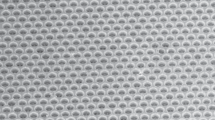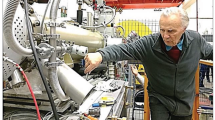Abstrac
t—A simple and economical method for manufacturing a cold cathode (electron generator) for a miniature and low-power X-ray emitter is described. The autoelectronic generator contains an assembly of two microchannel plates (MCPs) of the chevron type with an emissive carbon layer of Graphite 33 conductive glue, which contains carbon nanostructures (CNSs). The operating voltage does not exceed 2000 V. The dependence of the electron-generator output current on the distance between the MCPs in the assembly is determined. Thus, when the gap is increased from 0.2 to 0.63 mm the maximum DC current value increases from 0.65 to 4 μA; when the gap is further increased to 1.4 mm, the current increases to 4.5 μA. It is established that the maximum current of the electron generator in the pulsed mode of 53 μA is achieved if the first MCP in the assembly with a CNS layer at the input end is supplied with a pulse voltage of 800 V, a frequency of 2.3 kHz, and an off-duty ratio of 28, while a constant voltage of 1200 V is fed to the second MCP. In this case, the gap between the MCPs in the assembly is 1.4 mm.
Similar content being viewed by others
Avoid common mistakes on your manuscript.
Much attention is paid to the study of field-emission (cold) cathodes due to the prospects of their use in X-ray tubes. The authors of [1] proposed a design of a low-power X-ray tube, in which one or several series-connected microchannel plates (MCPs) are used as an electron-beam generator. A glass MCP is an electron amplifier that contains a large number of cylindrical channels with identical geometric dimensions and secondary-emission properties. The constant operating voltage of a standard MCP is 400–1200 V; the gain of the electron flow is 100–10 000. The MCP channels have the unique property of self-saturation; i.e., when the input current increases the output current increases and reaches the limiting value. When a voltage is applied to the ends of a single plate or an MCP assembly on a stationary metal electrode, which is pressed close to the end of the MCP, due to the field electron emission, a comparatively weak electric current occurs. The emission current is multiplied in the MCP volume, and the electron flow from the MCP output surface then arrives at the anode.
In order to operate such a field-emission electron generator, a voltage of up to 3000 V must be applied to the MCP at a current of several microamperes, so that the generator-dissipated power is only a few milliwatts. At the same time, unlike traditional X-ray tubes with a heated cathode, in which the filament is heated using a separate current source, only a voltage source is required and no special requirements are imposed on the source cooling. However, the device described in [1] has a significant drawback: the voltage at the stationary electrode is rather high, since the work function of electrons from the smooth inner surface of the electrodes inside the MCP is quite high (from 2 to 5 eV). This imposes restrictions on the use of cold cathodes in X-ray tubes.
In contrast to the electron generator described in [1], an MCP-based cold-cathode design was proposed in [2, 3]. An emissive carbon film that contains carbon nanostructures (CNSs), which are emission centers, is deposited on the end surface of the MCP; thus, a carbon film with a CNS but not a metal electrode is the electron emitter. Due to the low work function for electrons (<1 eV), carbon nanostructures (graphene, carbon nanotubes, nanographites, and nanodiamonds) are more promising materials for creating cold emission cathodes. Their use provides a significant decrease in the cathode supply voltage. The maximum cathode current depends mainly on the quantity and quality of CNSs that are formed in the carbon film. However, preparing a carbon medium with high emission properties is a complex scientific and technological task.
The objective of this research was to study the possibility of creating a simple and cost-effective source of cold cathodes for low-power X-ray tubes based on MCPs with an emissive medium of carbon nanostructures, which operate at low currents and voltages. We have proposed and describe below a cold cathode based on MCPs with an emission film made of Graphite 33 conductive glue (produced in Belgium), which is widely used to create contacts on solid substrates [4].
We used MCP plates with chromium contacts with a working-surface diameter of 18 mm and a thickness of 0.3 mm (RSO-Alaniya, Vladikavkaz, LLC VTTs Baspik). The diameter of the channels in the MCPs was 6 μm, while the angle of inclination of the channels was 5°. A solid carbon layer with a diameter of 7 mm and a thickness of ~20 μm was applied to the end surface of the MCP using Graphite 33 aerosol glue. To anneal the varnish component, the film was heated to 90°C in air at atmospheric pressure for 1 h. The diagram of the cathode on the basis of an MCP with a fluorescent screen is shown in Fig. 1.
Figure 2a shows a photograph of the carbon film at the center of the MCP, while Fig. 2b shows its field-emission image.
As shown by measurements of the current–voltage characteristics of the cathode, when applying voltages in a range of 600–1200 V, a weak electric current of up to tenths of microamperes occurs at the cathode output. The maximum cathode current was 0.2 μA at a voltage of 1200 V. It was natural to assume that carbon nanostructures in the graphite layer of the Graphite 33 glue are the source of field-emission electrons.
We proposed to use an assembly of two chevron-type MCPs to increase the cold-cathode output current. In the chevron assembly, the mutual arrangement of channels in the MCP has a V-type shape, as shown in Fig. 3. When a voltage is applied to the plates of the assembly, the electron flow that occurs in the first plate (MCP1) with an emission graphite-glue carbon film is amplified in the second plate (MCP2) of the assembly and then fed to the anode.
The design of the cathode device, which consists of two MCPs with CNSs at the input of the MCP1, is shown schematically in Fig. 4.
Figure 5 shows photographs of the device in a fluoroplastic housing (Fig. 5a) and a 0.2-mm-thick nickel contact ring (Fig. 5b). A schematic diagram of the installation for measuring the emission current of the cathode that consists of two MCPs is shown in Fig. 6.
The current measurements were performed in a vacuum chamber at a pressure of ~10–6 Torr. The anode was a plate of Kh20N80 stainless steel with a diameter of 18 mm and a thickness of 0.3 mm. The distance d between the MCPs at the first stage of the current measurement was 0.2 mm; the voltage at the MCP2 was 1200 V. The results of measuring the dependence of the cathode current IА on the voltage U1 at MCP1 are presented below:
U1, V | 655 | 667 | 677 | 689 | 700 | 710 | 740 | 750 | 764 | 774 | 786 | 800 |
IА, μA | 0.09 | 0.09 | 0.1 | 0.12 | 0.13 | 0.15 | 0.35 | 0.39 | 0.45 | 0.53 | 0.55 | 0.65 |
According to these data, the cathode current reaches IА = 0.65 μA for a voltage of U1 = 800 V.
It was further revealed that for the above-mentioned voltages at MCP1 and MCP2, an increase in the distance between these plates to 0.63 mm leads to a current rise to 4 μA; when the distance increases further to 1.4 mm, the current rises to 4.5 μA.
The maximum current of the electron generator was also measured when operating in the pulsed mode under the following conditions: voltage pulses with an amplitude of 800 V, a frequency of 2.3 kHz, and an off-duty ratio of 28 were fed to MCP1, while a DC voltage of 1200 V was fed to MCP2. The gap width between the plates was 1.4 mm. The maximum current in the pulsed mode was 53 µA.
Thus, a simple and cost-effective method for manufacturing a cold cathode (electron generator), which is based on the assembly of two chevron-type MCPs with an emissive carbon layer of Graphite 33 conductive glue, is proposed. The electron generator can be used to power a miniature low-power X-ray emitter and does not require a high-voltage source (an operating voltage of up to 2000 V is sufficient).
Using a layer of Graphite 33 graphite glue as a field-emission source of the cold cathode allows one to significantly reduce the cost of an MCP-based cold cathode and simplify its manufacturing technology, while the use of an assembly of two MCPs makes it possible to significantly increase the cathode output current. If a solid carbon layer that is deposited on the MCP end is thicker than the channel diameter, it will block the MCP channels. In this case, the depth of the film penetration into the channel is approximately equal to the channel diameter. When a thin film is deposited the channels do not close. An electrical contact was created via deposition of a copper layer on a solid carbon film in [3], since the carbon diffusion coefficient in copper is extremely low. In our experiment, the carbon layer does not contact directly with the contact, i.e., with the nickel ring electrode.
REFERENCES
Elam, W.T., Kelliher, W.C., Hershyn, W., and Delong, D.P., US Patent 8081734B2, 2011.
Khamdokhov, Z.M., Margushev, Z.Ch., Khamdo-khov, E.Z., Teshev, R.Sh., and Bavizhev, M.D., Semiconductors, 2019, vol. 53, no. 15, p. 63. https://doi.org/10.1134/S1063782619150090
Khamdokhov, Z.M., Margushev, Z.Ch., Khamdo-khov, E.Z., Teshev, R.Sh., and Bavizhev, M.D., Izv. Vyssh. Uchebn. Zaved., Elektron., 2018, vol. 23, no. 6, p. 630. https://doi.org/10.24151/1561-5405-2018-23-6-630-63
https://supply24.online/oborudovanie_masterskih/himicheskie-preparaty/zaschitnye-iekraniruyuschie-obolochki/tokoprovodyaschee-pokrytie-kontakt-chemie-33-200.
Author information
Authors and Affiliations
Corresponding author
Additional information
Translated by A. Seferov
Rights and permissions
About this article
Cite this article
Khamdokhov, Z.M., Fedotova, G.V., Samodurov, P.S. et al. Cold Cathodes Based on an Assembly of Microchannel Plates for Low-Power X-Ray Tubes. Instrum Exp Tech 64, 117–120 (2021). https://doi.org/10.1134/S0020441220060172
Received:
Revised:
Accepted:
Published:
Issue Date:
DOI: https://doi.org/10.1134/S0020441220060172










